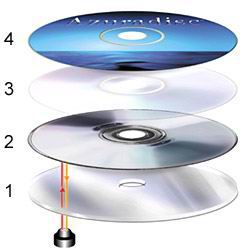CDs consist of 99% clear polycarbonate plastic. The reflective layer, protective layer and screen print comprise the remaining 1% of the disc.
- A disc is created from molten polycarbonate and digital information is stamped on the top of the disc, while it is still near melting point, using a die with microscopic bumps. These bumps are known as “pits and lands”.
- After the information is molded into the poly- carbonate, a reflective foil layer is applied using a process called sputtering or wet silvering. This layer reflects the laser back to the player, so it’s integrity is extremely important. The layer is usually silver, but can be made of gold or platinum.
- A clear lacquer coating is applied to seal the reflective layer and prevent oxidation. This layer is very thin and offers little protection from top side scratches.
- Finally the artwork is screen-printed on the top of the disc.
Pits and Lands are imprinted into the disc to indicate a one or a zero. A laser beam is sent from the player to the disc and the reflective layer reflects it back to the reader and the ones and zeros are translated by the player.
Recordable discs have a photosensitive dye type layer instead of the stamped information layer. This layer, when exposed to a certain light, will make an impression of a pit into the layer.
Re-recordable discs use a layer that allows the laser to polarize the photosensitive layer back and forth between a visible pit to an invisible pit.
Here is a video of how CD’s are made
[youtube]http://www.youtube.com/watch?v=O3FQzwNzUE4[/youtube]
How a Blu-ray is Made
Unlike current DVDs, which use a red laser to read and write data, Blu-ray uses a blue laser (which is where the format gets its name). A blue laser has a shorter wavelength (405 nanometers) than a red laser (650 nanometers). The smaller beam focuses more precisely, enabling it to read information recorded in pits that are only 0.15 microns (µm) (1 micron = 10-6 meters) long — this is more than twice as small as the pits on a DVD. Plus, Blu-ray has reduced the track pitch from 0.74 microns to 0.32 microns. The smaller pits, smaller beam and shorter track pitch together enable a single-layer Blu-ray disc to hold more than 25 GB of information — about five times the amount of information that can be stored on a DVD.
Blu-ray discs not only have more storage capacity than traditional DVDs, but they also offer a new level of interactivity. Users will be able to connect to the Internet and instantly download subtitles and other interactive movie features. With Blu-ray, you can:
• record high-definition television (HDTV) without any quality loss
• instantly skip to any spot on the disc
• record one program while watching another on the disc
• create playlists
• edit or reorder programs recorded on the disc
• automatically search for an empty space on the disc to avoid recording over a program
• access the Web to download subtitles and other extra features
Each Blu-ray disc is about the same thickness (1.2 millimeters) as a DVD. But the two types of discs store data differently. In a DVD, the data is sandwiched between two polycarbonate layers, each 0.6-mm thick. Having a polycarbonate layer on top of the data can cause a problem called birefringence, in which the substrate layer refracts the laser light into two separate beams. If the beam is split too widely, the disc cannot be read. Also, if the DVD surface is not exactly flat, and is therefore not exactly perpendicular to the beam, it can lead to a problem known as disc tilt, in which the laser beam is distorted. All of these issues lead to a very involved manufacturing process.
Bluray disc and HD DVD Production Tour
[youtube]http://www.youtube.com/watch?v=Wd_nR6ps5xY[/youtube]
How a DVD is Made
DVDs are made in different ways depending on the amount of information that is recorded on the disc. DVDs may be single or double layered and single or double layered double sided.
Single Layer DVDs (DVD-5 – 4.7GB)
These DVDs are made the same way as a CD with one additional polycarbonate layer added between the label and the pits and lands.
Double Layered DVDs (DVD-9 – 8.5GB)
Double layered DVDs have a semi reflective layer and a reflective layer giving two layers to store information.
Double Sided DVDs (DVD-10 – 9.4GB)
Double sided DVDs consist of two discs bonded back to back with the reflective layers in the middle and both sides are repairable. Double sided DVDs use a different size of micro-abrasive polishing papers to prevent the manufacturer’s label area from being removed during the repair process.
Double Sided/Double Layered DVDs (DVD-18 – 17.1GB)
Double sided/double layered DVDs are simply two double layered discs bonded back to back.
How DVDR / DVD R is made
[youtube]http://www.youtube.com/watch?v=Qqlgtvwjml4[/youtube]
Finally, How a CD ROM Works Animation
[youtube]http://www.youtube.com/watch?v=ESpL4a08kVE[/youtube]








